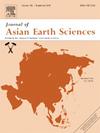奥陶系—志留系过渡时期长江氧化还原转化:富有机质页岩锌同位素证据
IF 2.7
3区 地球科学
Q2 GEOSCIENCES, MULTIDISCIPLINARY
引用次数: 0
摘要
在奥陶系—志留系过渡时期,受多种环境因素的影响,长江呈现出复杂的氧化还原模式。因此,研究这一现象对于理解古环境变化及其意义至关重要。大量不断演化的地球化学指标提供了对古海洋氧化还原条件的认识,其中富有机质页岩中的锌同位素组成(δ66Zn)最近被发现作为当地海洋氧化还原条件的潜在替代指标。本研究选择在中扬子陆架钻探的JY143岩心作为研究对象。δ66Zn值的变化可分为三个阶段。来自火成岩物质的大量同位素轻锌流入及其与海水的相互作用可能导致海水中锌同位素组成总体较轻(δ66Znsw)。在古生产力高、有机质埋藏率高的条件下,生物吸收是富有机质页岩δ66Zn值低的主要原因,表明富有机质页岩在过渡时期是一个同位素轻Zn汇。值得注意的是,第1阶段的δ66Znsw值明显低于第2和第3阶段,也低于造岩源,这可能是由于在成岩早期,孔隙水中相对于ZnS的多余同位素轻Zn在氧化条件下被再活化并释放到深部海水中。综上所述,从缺氧环境到缺氧(甚至缺氧)环境的转变导致δ66Znsw值显著增加。本研究提供了关于过渡时期扬子海域缺氧-缺氧(甚至缺氧)转化的新证据,同时进一步强调了δ66Zn在富有机质页岩中作为局部古海洋环境氧化还原指标的潜在应用价值。本文章由计算机程序翻译,如有差异,请以英文原文为准。
The redox transformation in the Yangtze Sea across the Ordovician-Silurian transition: Evidence from zinc isotopes in organic-rich shales
Across the Ordovician-Silurian transition, the Yangtze Sea exhibited a complex redox pattern influenced by various environmental factors. Consequently, investigating this phenomenon is crucial for understanding the paleoenvironmental changes and their implications. Numerous and continuously evolving geochemical proxies provide insights into the redox conditions of paleo-oceans, among which the zinc isotope composition (δ66Zn) in organic rich shales has been recently discovered as a potential alternative proxy for local marine redox conditions. In this study, the core JY143, drilled in the middle Yangtze shelf, was selected as the research subject. The variation in δ66Zn values can be categorized into three distinct stages. The substantial influx of isotopically light Zn from igneous materials and its interaction with seawater may contribute to an overall lighter Zn isotope composition in seawater (δ66Znsw). Under conditions characterized by high paleoproductivity and elevated organic burial rates, biological absorption of light Zn is primarily responsible for the low δ66Zn values observed in organic-rich shales, indicating that organic-rich shales serve as an isotopically light Zn sink in the Yangtze Sea across the transition. Notably, the δ66Znsw values observed during stage 1 are significantly lower than those recorded in stages 2 and 3, as well as below lithogenic source, possibly because during the early diagenetic stage, an excess of isotopically light Zn relative to ZnS in pore water was remobilized and subsequently released into deep seawater under oxidizing conditions. In summary, the transformation from an oxic environment to an anoxic (and even euxinic) environment resulted in a marked increase in δ66Znsw values. This study presents new evidence from Zn isotopes regarding the oxic-anoxic (and even euxinic) transformation in the Yangtze Sea during the transition, while further underscoring the potential utility of δ66Zn in organic-rich shales as a redox proxy for local paleo-ocean environments.
求助全文
通过发布文献求助,成功后即可免费获取论文全文。
去求助
来源期刊

Journal of Asian Earth Sciences
地学-地球科学综合
CiteScore
5.90
自引率
10.00%
发文量
324
审稿时长
71 days
期刊介绍:
Journal of Asian Earth Sciences has an open access mirror journal Journal of Asian Earth Sciences: X, sharing the same aims and scope, editorial team, submission system and rigorous peer review.
The Journal of Asian Earth Sciences is an international interdisciplinary journal devoted to all aspects of research related to the solid Earth Sciences of Asia. The Journal publishes high quality, peer-reviewed scientific papers on the regional geology, tectonics, geochemistry and geophysics of Asia. It will be devoted primarily to research papers but short communications relating to new developments of broad interest, reviews and book reviews will also be included. Papers must have international appeal and should present work of more than local significance.
The scope includes deep processes of the Asian continent and its adjacent oceans; seismology and earthquakes; orogeny, magmatism, metamorphism and volcanism; growth, deformation and destruction of the Asian crust; crust-mantle interaction; evolution of life (early life, biostratigraphy, biogeography and mass-extinction); fluids, fluxes and reservoirs of mineral and energy resources; surface processes (weathering, erosion, transport and deposition of sediments) and resulting geomorphology; and the response of the Earth to global climate change as viewed within the Asian continent and surrounding oceans.
 求助内容:
求助内容: 应助结果提醒方式:
应助结果提醒方式:


